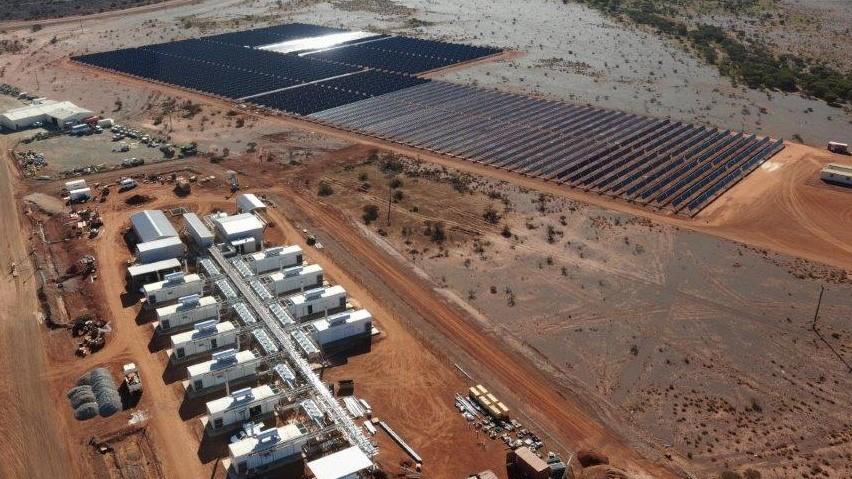A 23 MW generation project integrating solar with gas and diesel has powered up at the Agnew Gold Mine, marking the completion of the first stage of one of Australia’s largest hybrid renewable microgrid projects. The project is part of Gold Fields’ plant to install a unique wind, solar, battery and gas microgrid at its mine in Western Australia.
The $112 million microgrid is built in two stages. The now completed Stage 1 involves a new off-grid power station incorporating 16 MW gas and 3 MW diesel generation and 4 MW photovoltaic solar. Stage 2 includes 18 MW wind generation, a 13 MW battery and an advanced microgrid control system, with construction underway and due for completion in 2020.
Billed as “the first large hybrid microgrid in the mining sector in Australia to integrate wind generation”, the Agnew project is developed with the help of $13.5 million from the Australian Renewable Energy Agency (ARENA). Once completed, it will have a total installed generation capacity of 54 MW, with renewables providing over 50% of the mine’s power requirements and potentially even more by adopting innovative operational practices such as the dynamic load shedding, renewables forecasting and load control management.
“With this project, EDL and Gold Fields are leading the way towards clean, renewable energy to power remote, off-grid mining operations without compromising reliability or power quality,” EDL CEO James Harman said. EDL will design, construct, own and operate the microgrid at the Agnew Gold Mine under a 10-year agreement with Gold Fields. The distributed energy producer has partnered with German-headquartered juwi to deliver the project.
For Gold Fields, the Stage 1 completion represents a significant milestone for strengthening its energy security, optimising energy costs and reducing its carbon footprint through the adoption of new technologies. “We are hopeful that this will also enable other companies to consider the options for decarbonising their operations,” Gold Fields Executive Vice President, Stuart Mathews, said.
The Stage 1 launch was attended by Western Australia Minister for Energy Bill Johnston, who congratulated EDL and Gold Fields for their collaborative work on the innovative project. “The McGowan Government is supportive of mining and resources companies that are embracing renewable energy solutions, particularly when it helps reduce their carbon emissions,” Johnston said. “This innovative, Australia-first project is setting the standard for mine sites throughout Western Australia.”
Elsewhere in Western Australia, a microgrid hybrid project, consisting of a 2.5 MW wind farm, a 1 MW solar farm and a 2 MW / 0.5 MWh battery, will provide up to 70% of the electricity needs of a nearby garnet mining and processing plant run by GMA Garnet.
In one of the biggest renewable energy projects in the resource sector, WA’s Pilbara region is set to be home to the first major iron ore mining operation in Australia to be run entirely off renewable energy during the day. The Chichester mining hub run by resources giant Fortescue Metals and built by Downer Group will be powered by a massive 60 MW solar farm coupled with a 35 MW/11 MWh battery facility.
Presently, Australia’s largest solar PV installation at the mining site is the DeGrussa project – a hybrid system located at Sandfire’s copper and gold mine site in Western Australia, which comprises a 10.6 MW solar facility coupled with a 6 MWh battery facility – integrated with an existing diesel generator. The project reached full operation in May 2016.
Other notable developments in Western Australia include a 7.3 MW solar array and 2 MW/1 MWh battery at the Granny Smith gold mine in the Eastern Goldfields region and a 6.7 MW solar PV array at the Nova nickel-copper mine located in the Fraser Range.
This content is protected by copyright and may not be reused. If you want to cooperate with us and would like to reuse some of our content, please contact: editors@pv-magazine.com.









1 comment
By submitting this form you agree to pv magazine using your data for the purposes of publishing your comment.
Your personal data will only be disclosed or otherwise transmitted to third parties for the purposes of spam filtering or if this is necessary for technical maintenance of the website. Any other transfer to third parties will not take place unless this is justified on the basis of applicable data protection regulations or if pv magazine is legally obliged to do so.
You may revoke this consent at any time with effect for the future, in which case your personal data will be deleted immediately. Otherwise, your data will be deleted if pv magazine has processed your request or the purpose of data storage is fulfilled.
Further information on data privacy can be found in our Data Protection Policy.